Before getting to the next mosque in our plan, and that was the Şehzade Mosque, Sneža and I passed by Valens Aqueduct.
As Constantinople in the past and Istanbul later were big cities with a lot of residents, it was important to provide sufficient quantity of potable water for all those people. For this reason, in the 4th century, Roman Emperor Valens had this aqueduct built and some parts of it have survived to date.
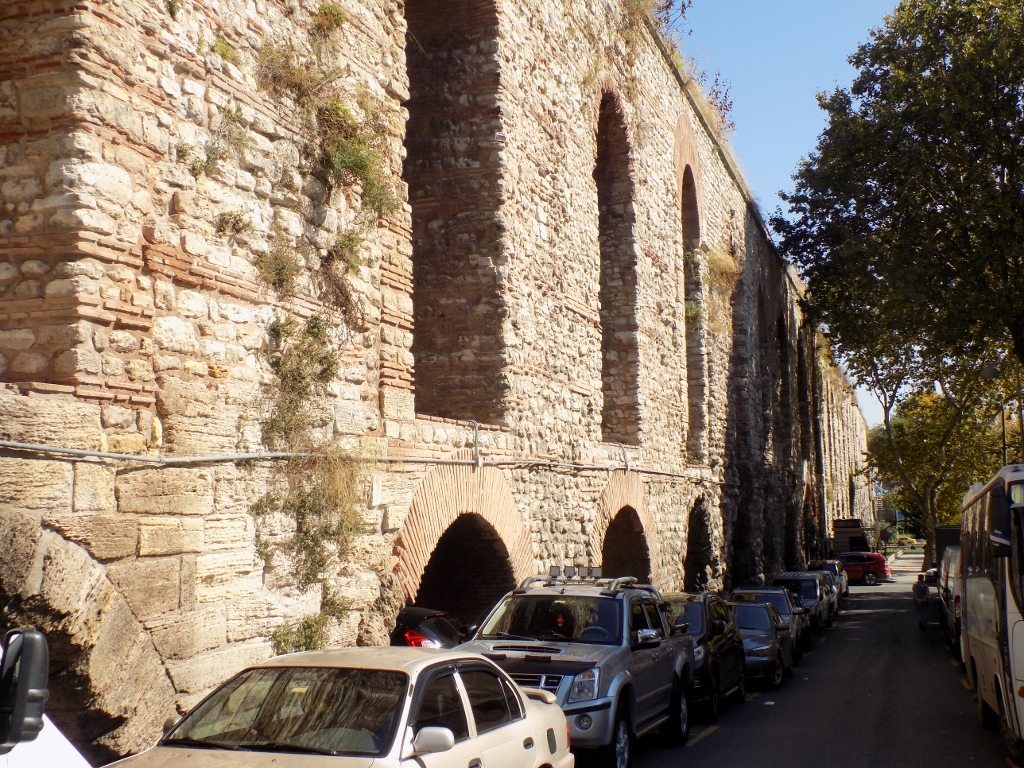 Valens Aqueduct
Valens Aqueduct
We approached it from a smaller street and kept passing from one side of it to the other using the arched passages that exist there, but the aqueduct is probably most interesting when seen from the direction of Atatürk Boulevard.
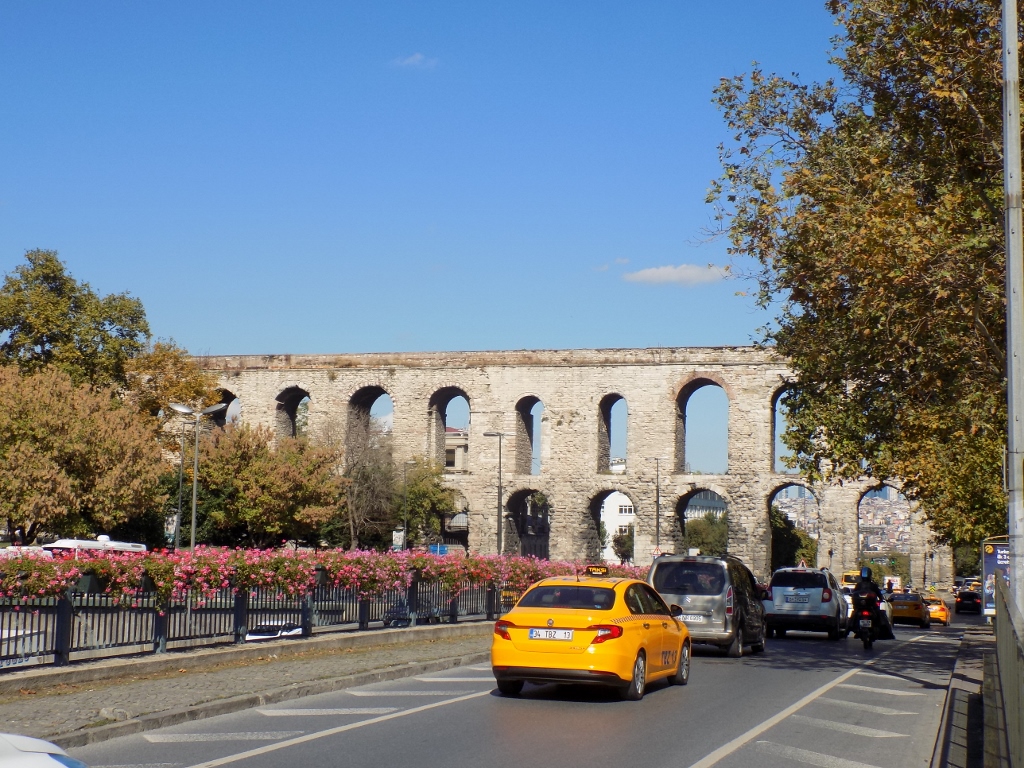 Valens Aqueduct
Valens Aqueduct
In the direct proximity of Valens Aqueduct, there is the Şehzade Mosque. This is a mosque which was (again) built by Sultan Suleiman the Magnificent in the 16th century, but this one was dedicated to his, apparently, favourite son and the heir apparent Prince Mehmed who died very young, at the age of 22. It is precisely the name of the mosque that suggests this, since “Şehzade” means “prince.”
The architect in charge of the construction of this mosque was Sinan or as he is often referred to Mimar Sinan (“mimar” meaning “architect”). This was the first mosque commissioned by a sultan which this famous architect of the Ottoman Empire designed.
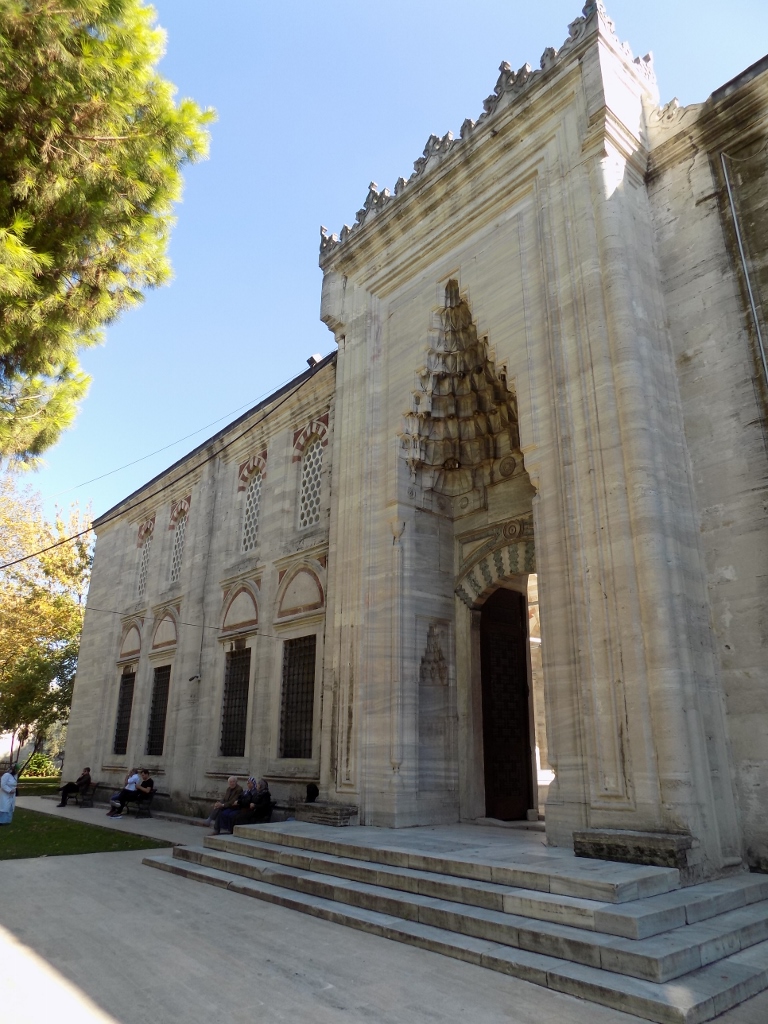 Main entrance into the Şehzade Mosque
Main entrance into the Şehzade Mosque
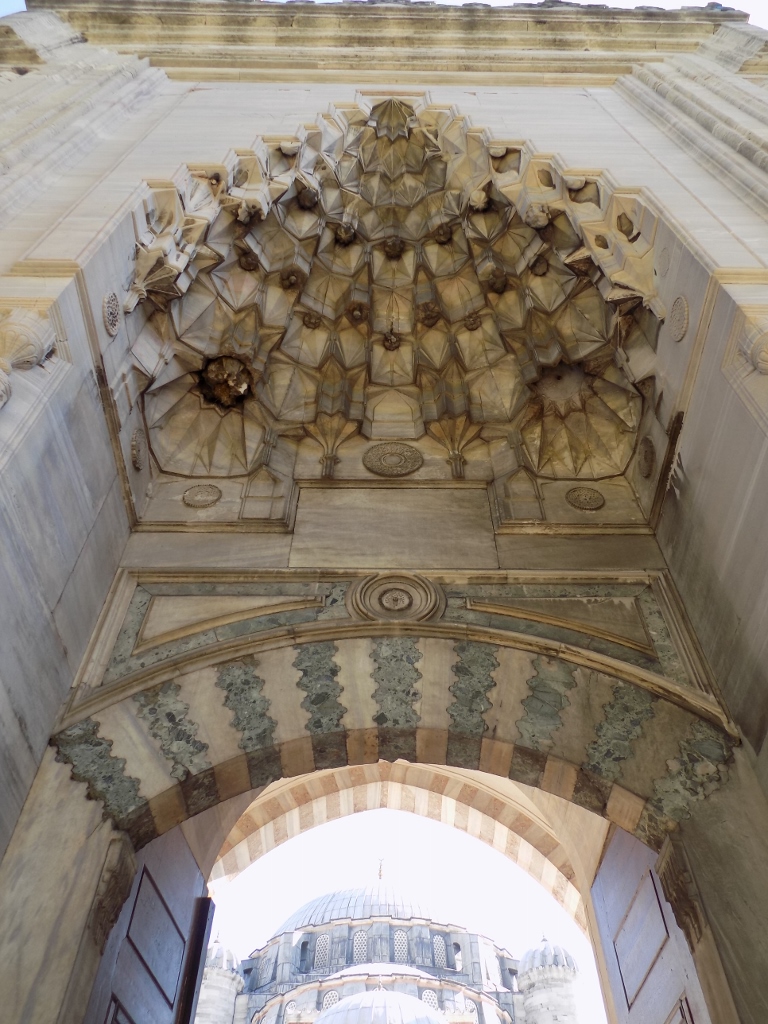 Very beautiful muqarnas that adorns the main entrance into the Şehzade Mosque
Very beautiful muqarnas that adorns the main entrance into the Şehzade Mosque
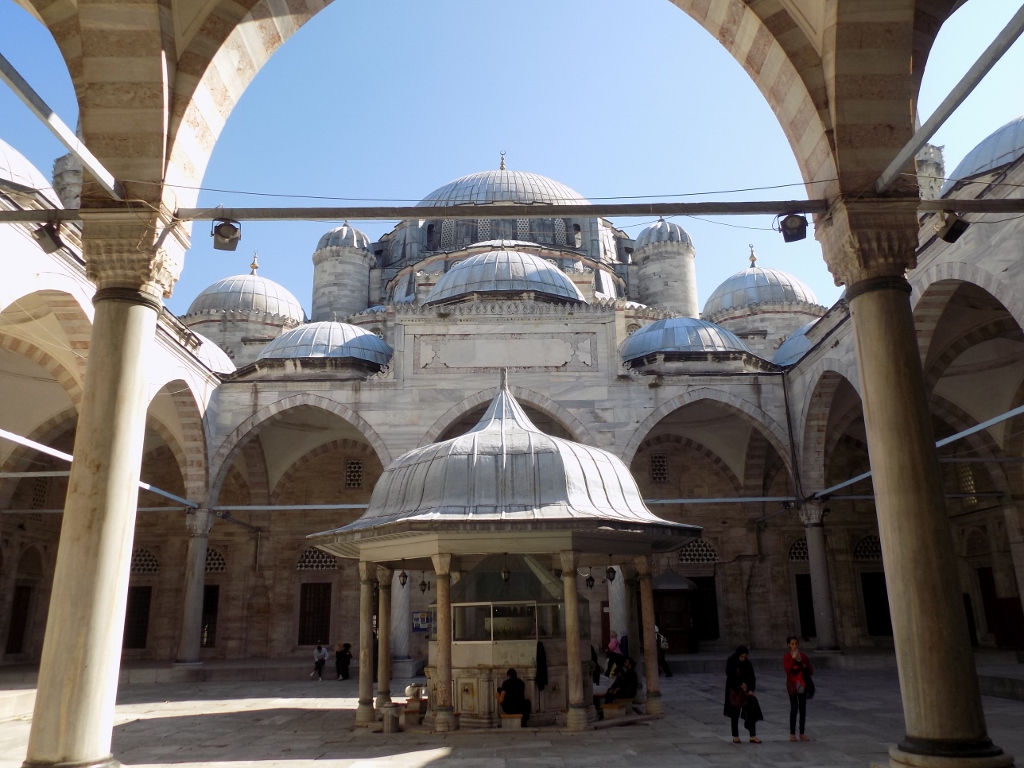 Forecourt of the Şehzade Mosque with the shadirvan
Forecourt of the Şehzade Mosque with the shadirvan
As it may be seen from the outside, it is also possible to see from the inside that the roof structure was made in the shape of a multitude of semi-domes that surround the central dome. When building such mosques, it was always important to ensure sufficient solidity and load-bearing capacity of the walls, and to make a sufficient number of windows in order to allow as much light to come in as possible, while making sure that the entire structure remains stable.
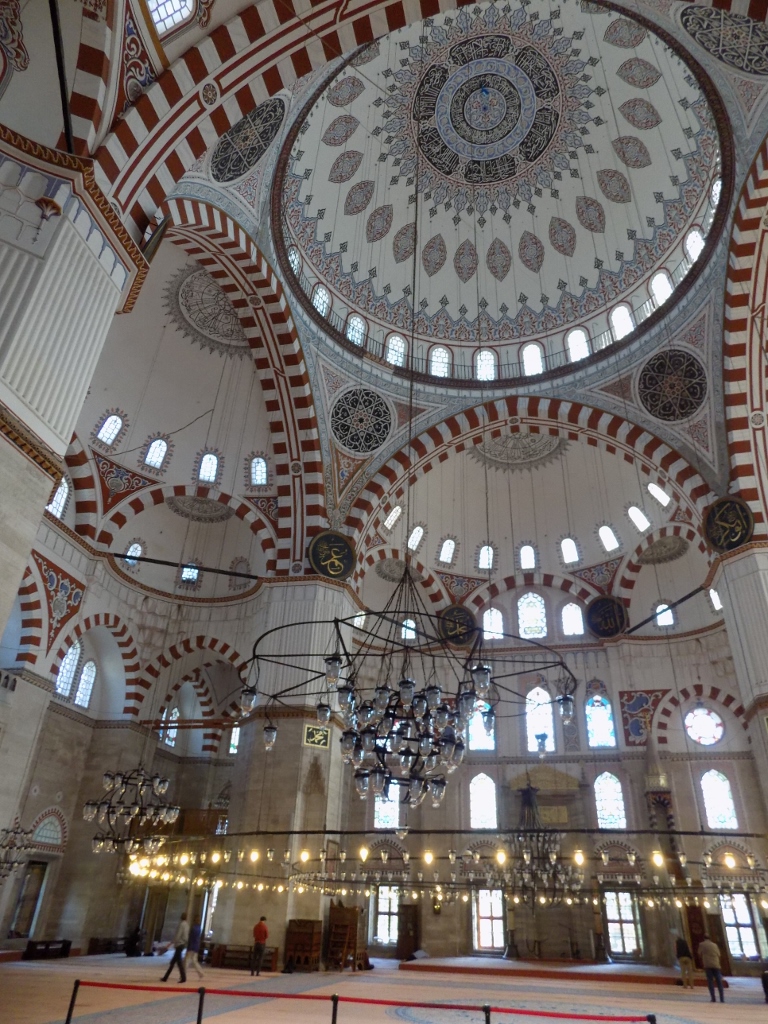 The interior of the Şehzade Mosque
The interior of the Şehzade Mosque
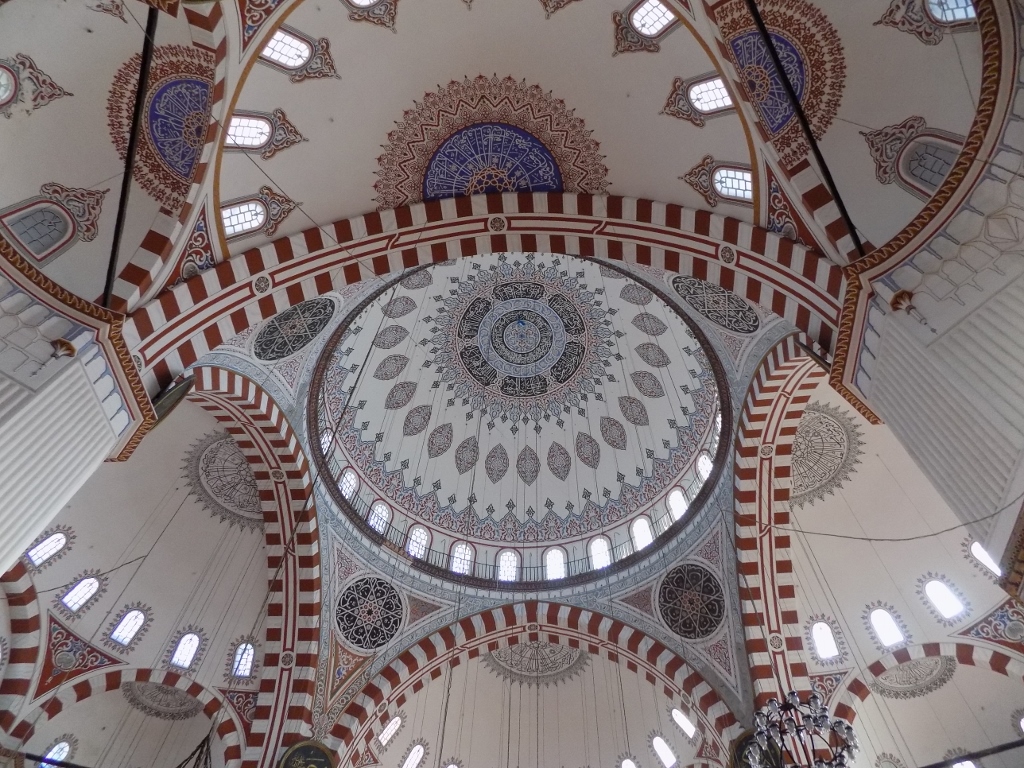 The interior of the Şehzade Mosque
The interior of the Şehzade Mosque
In the case of this mosque there are two slender minarets as well, both 55 metres tall, and they rise one on each side. They are marked by two balconies, as well as decoration in the form of bas-relief, which is a unique case in the opus of architect Sinan.
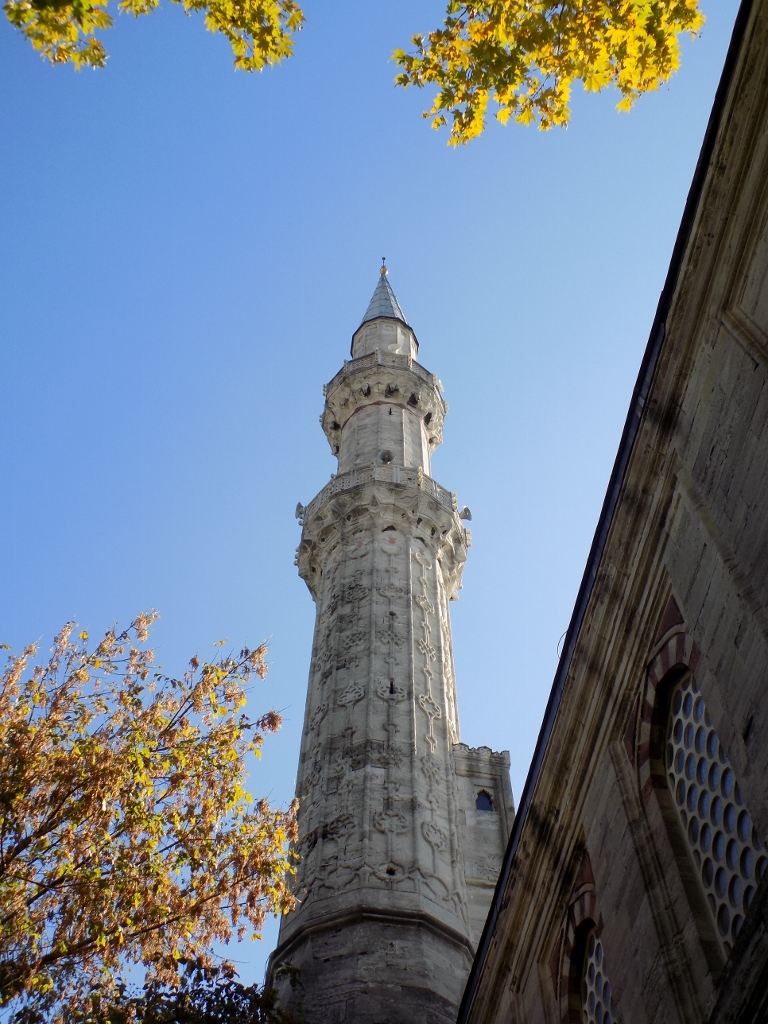 Minaret belonging to the Şehzade Mosque
Minaret belonging to the Şehzade Mosque
This complex also includes a courtyard behind the mosque where there is a cemetery.
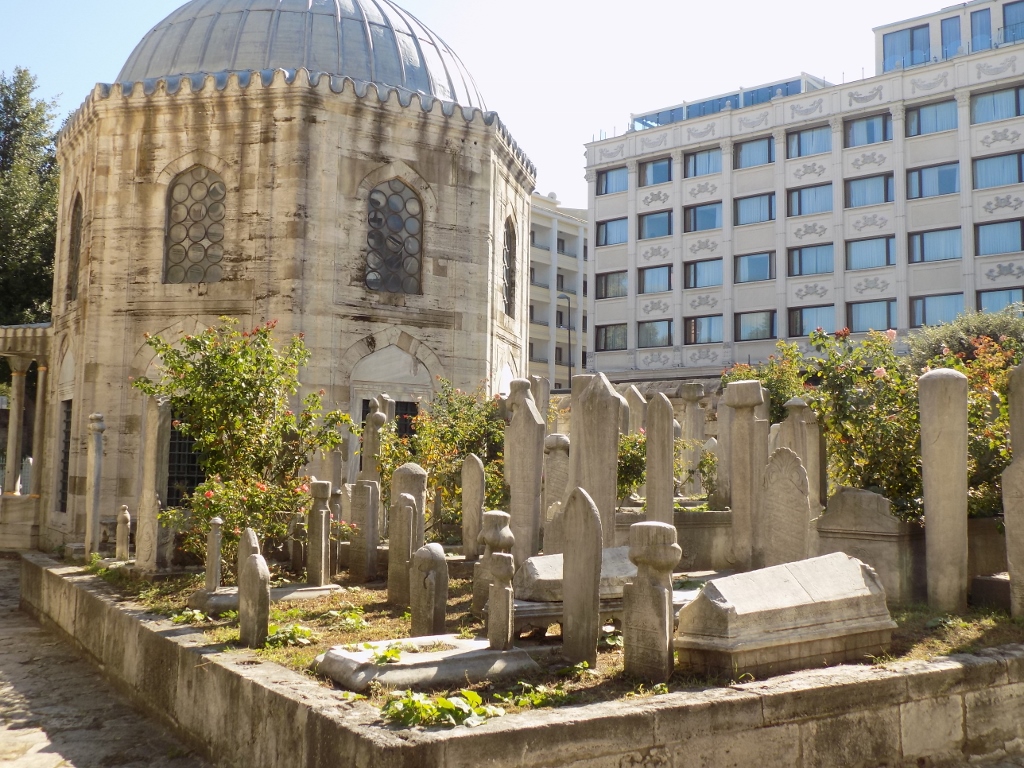 Cemetery behind the Şehzade Mosque: the türbe of Rüstem Pasha, made by architect Sinan
Cemetery behind the Şehzade Mosque: the türbe of Rüstem Pasha, made by architect Sinan
This cemetery should certainly be visited, not only in order to see some of the tombs, but also in order to admire the details of the mosque.
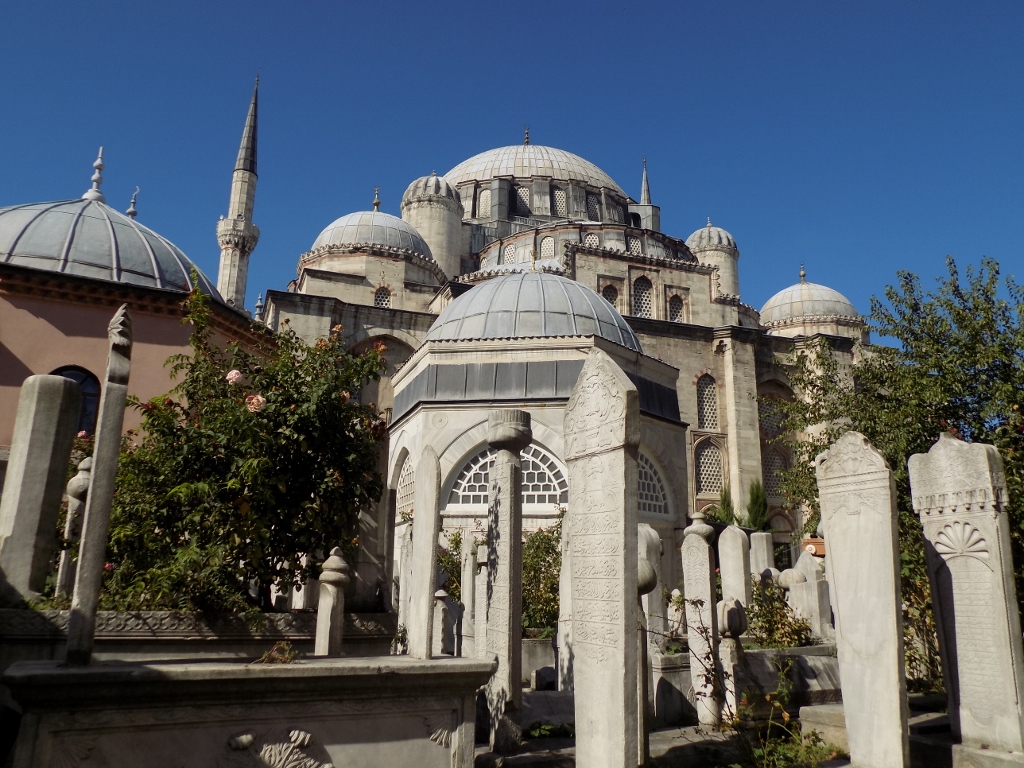 Cemetery behind the Şehzade Mosque: view at the back side of the Şehzade Mosque
Cemetery behind the Şehzade Mosque: view at the back side of the Şehzade Mosque
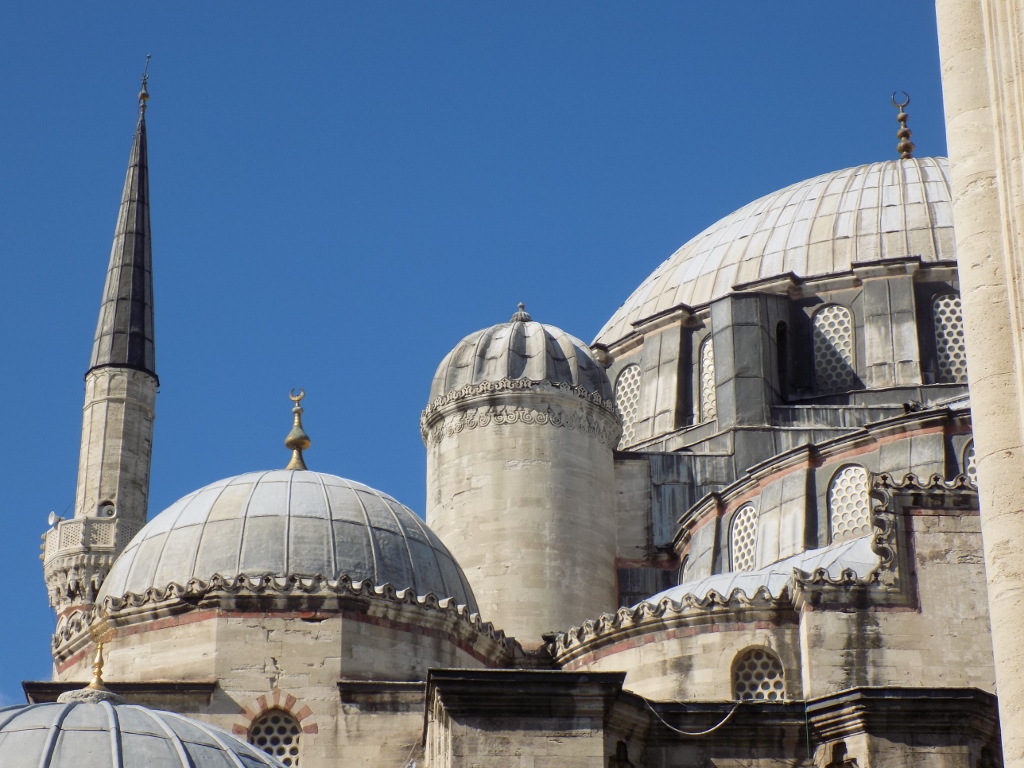 Details of the Şehzade Mosque
Details of the Şehzade Mosque
The cemetery holds the türbe of this unfortunate young prince as well. The sepulchre was also designed by architect Sinan and it is a true master-piece with the wonderfully built dome, the façade made of stones of different colours, while the interior is very pretty and interesting, too.
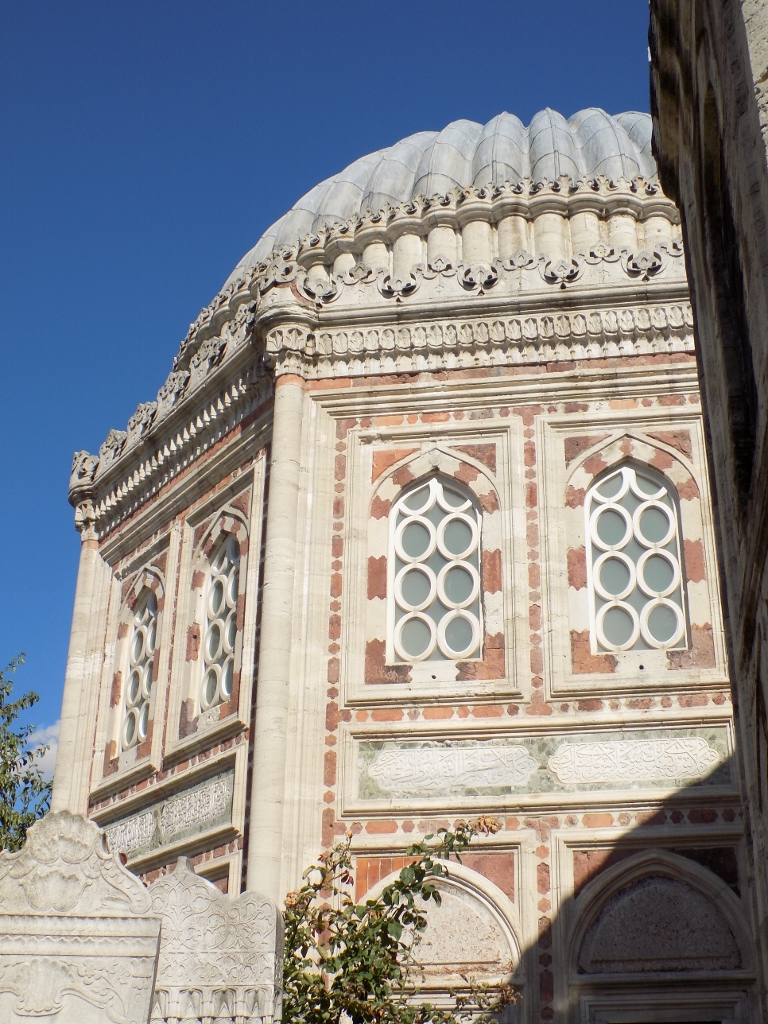 Türbe of Prince Mehmed
Türbe of Prince Mehmed
At the time we were there, the tomb was in fact closed for visits, but we could peer through the window. The interior is also spectacular, with fantastic tiles, and there is an interesting and unusual wooden throne above the grave of the prince himself, thus emphasising that he was the heir apparent.
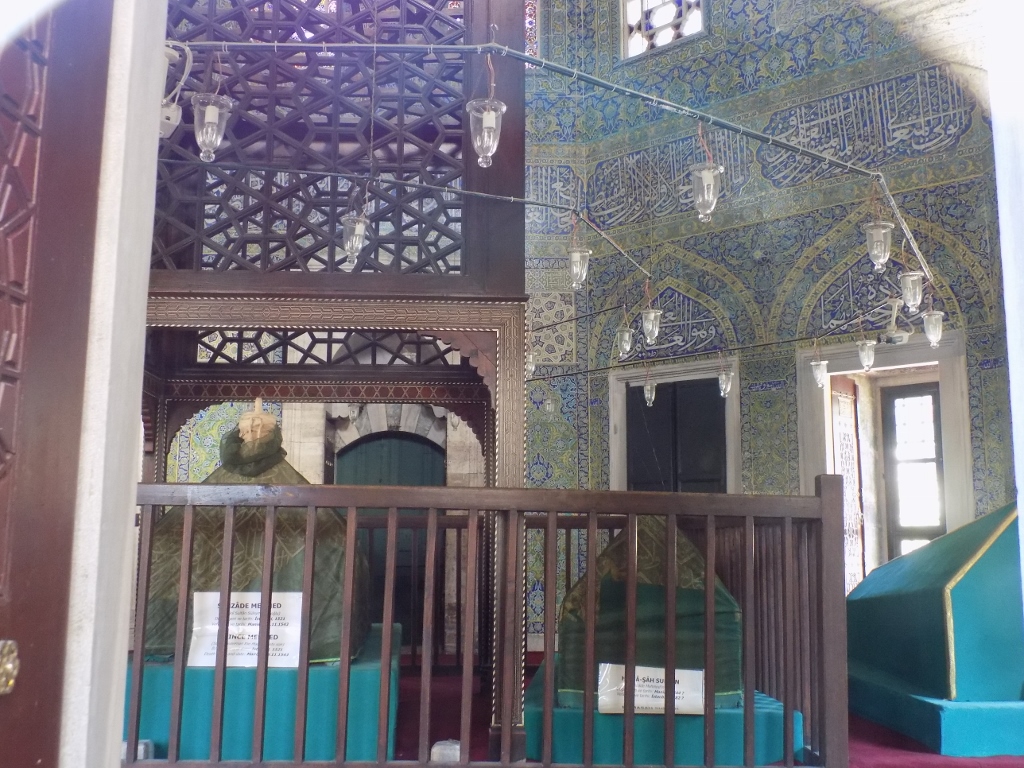 Türbe of Prince Mehmed: the interior
Türbe of Prince Mehmed: the interior
Not so far away from here, after some 15 minutes on foot, we came to the most magnificent imperial mosque in Istanbul – the Süleymaniye Mosque. The mosque was commissioned by Sultan Suleiman the Magnificent, while the main designer was, as I’ve mentioned earlier, the most famous architect of the Ottoman Empire – Sinan.
We approached the mosque walking along a narrow street on one side of which there is a library belonging to this complex, while on the other side are some other educational institutions. Generally speaking, these imperial mosques that I mention we visited were not built as sole edifices, but there were always entire complexes that incorporated different institutions and this complex concretely included schools of different levels – medreses, a library, a hospital, an inn – caravanserai, a soup kitchen, as well as public baths – hamam.
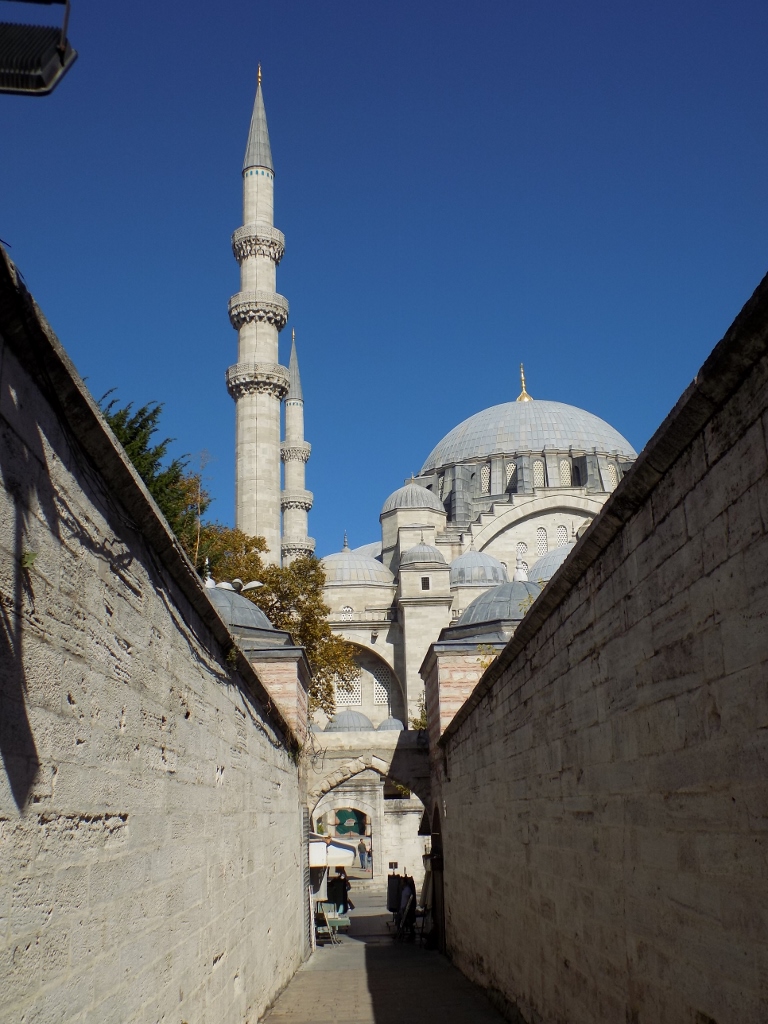 Approaching the Süleymaniye Mosque
Approaching the Süleymaniye Mosque
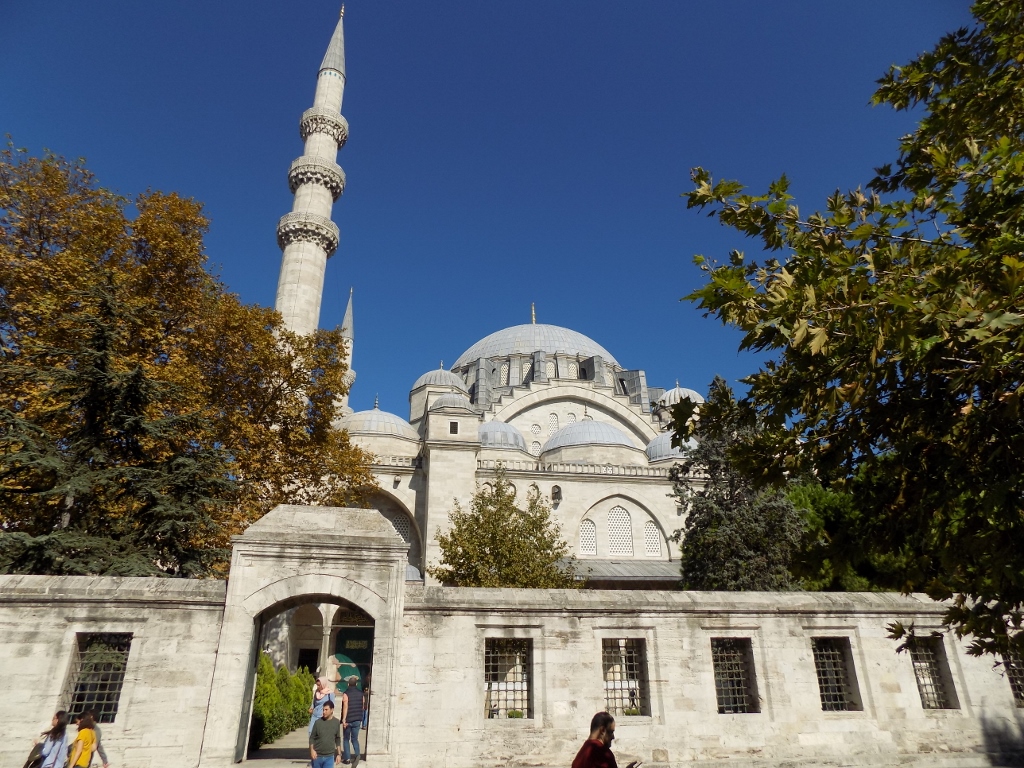 One of the entrances into the park area surrounding the Süleymaniye Mosque
One of the entrances into the park area surrounding the Süleymaniye Mosque
After we had entered the green area that extends around the mosque, we went to the main entrance since there is certain appeal when you enter the front courtyard from that side.
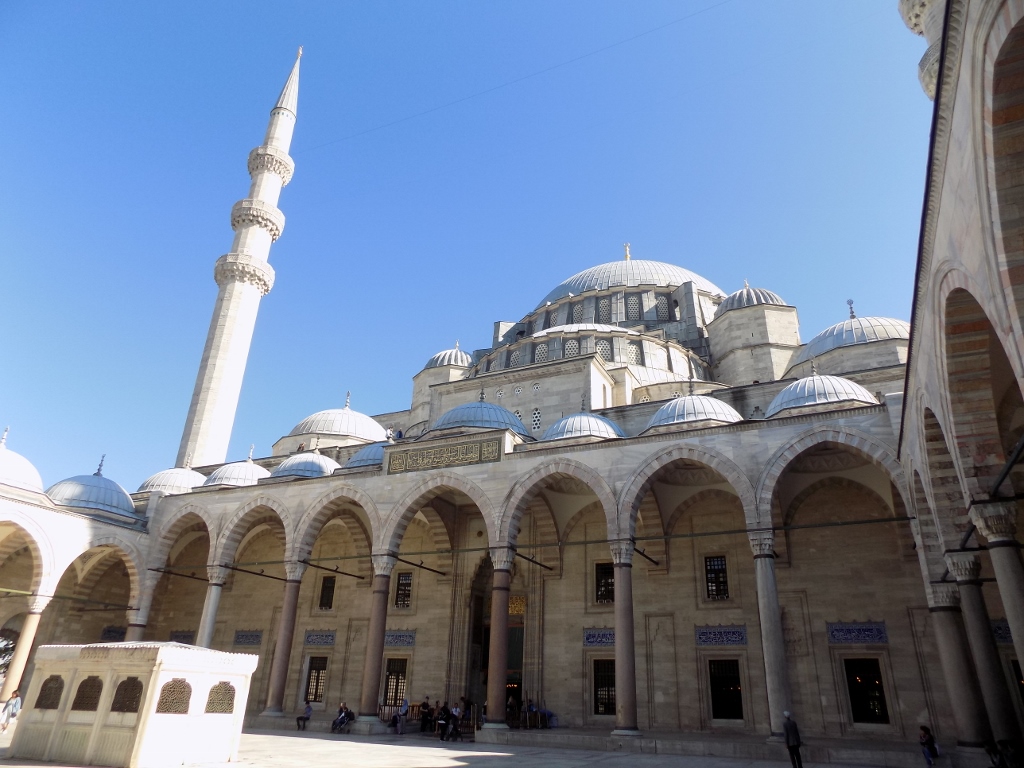 Forecourt of the Süleymaniye Mosque with a rectangular shadrivan
Forecourt of the Süleymaniye Mosque with a rectangular shadrivan
This mosque has four minarets, on the four corners of the forecourt. This also means that this is a sultan’s mosque, since only sultans were allowed to build four minarets. Princes and princesses could build mosques with two minarets and the rest only with one. Two front minarets at the Süleymaniye Mosque are lower and have two galleries each, while the two closer to the mosque itself have three galleries each (as seen in the photo above) and they are 76 metres tall, including the lead roof.
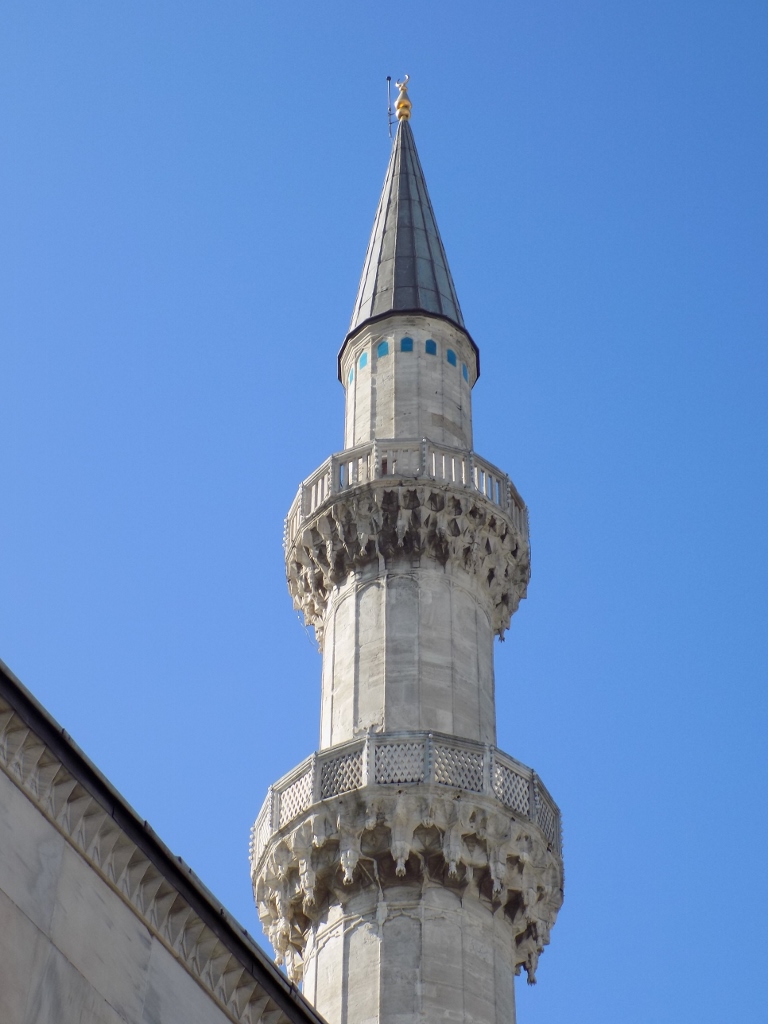 Front minaret of the Süleymaniye Mosque
Front minaret of the Süleymaniye Mosque
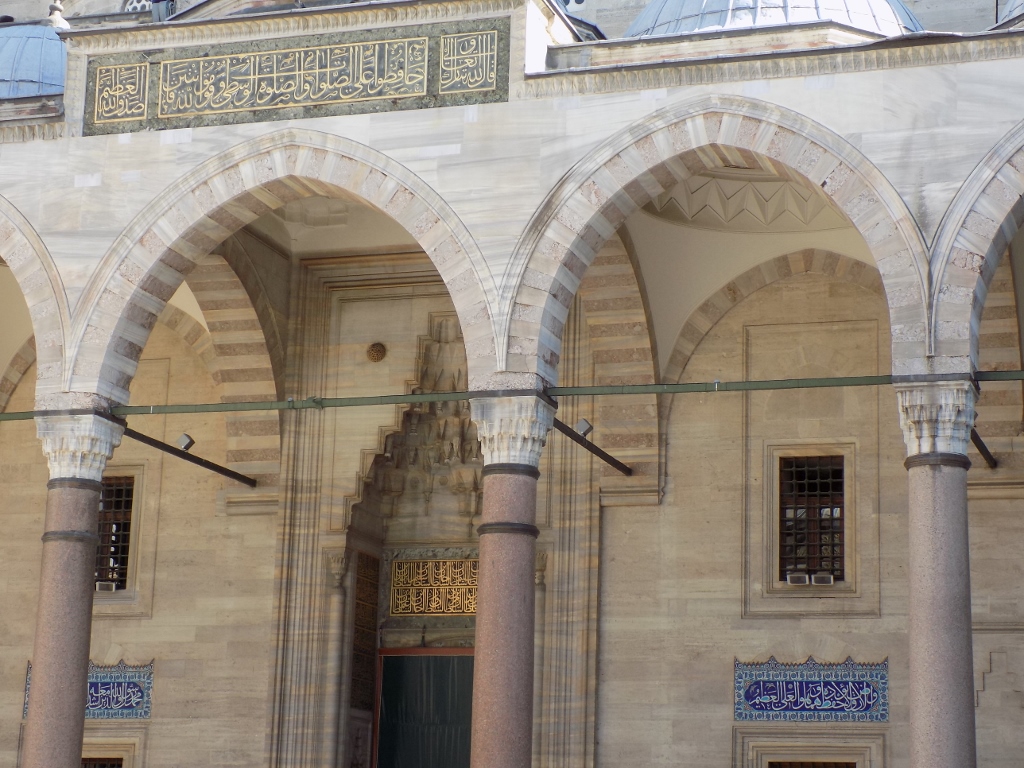 A detail from the forecourt of the Süleymaniye Mosque
A detail from the forecourt of the Süleymaniye Mosque
When we took our shoes off (our heads had already been covered) and entered the mosque, we were truly impressed. In the case of this mosque, the majority of the windows through which the sunlight pours in are located on the east and the west sides of the edifice.
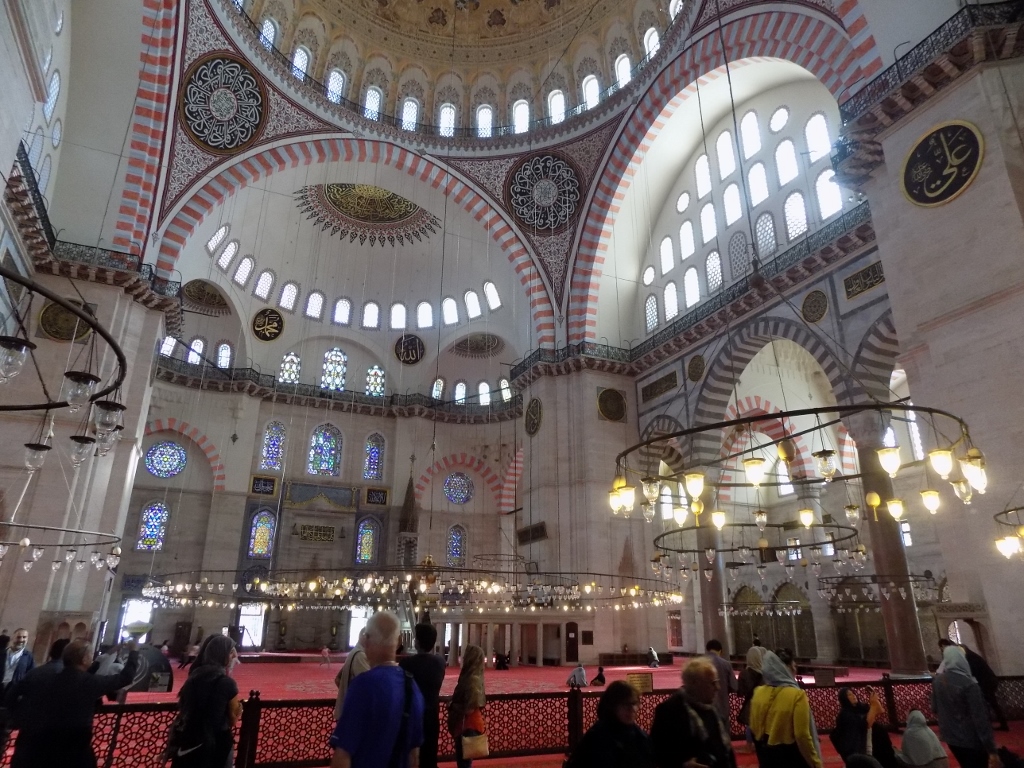 Süleymaniye Mosque
Süleymaniye Mosque
The main dome is also impressive with its 53 metres of height, while its diameter is exactly a half of this figure, i.e., 26.5 metres.
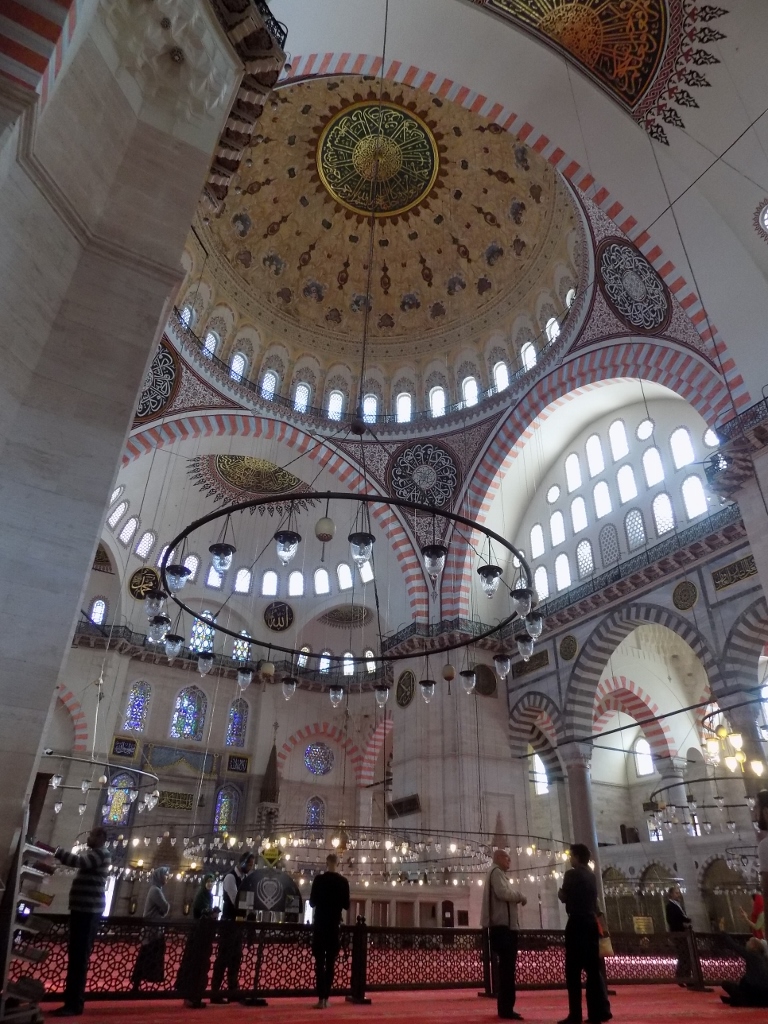 Süleymaniye Mosque
Süleymaniye Mosque
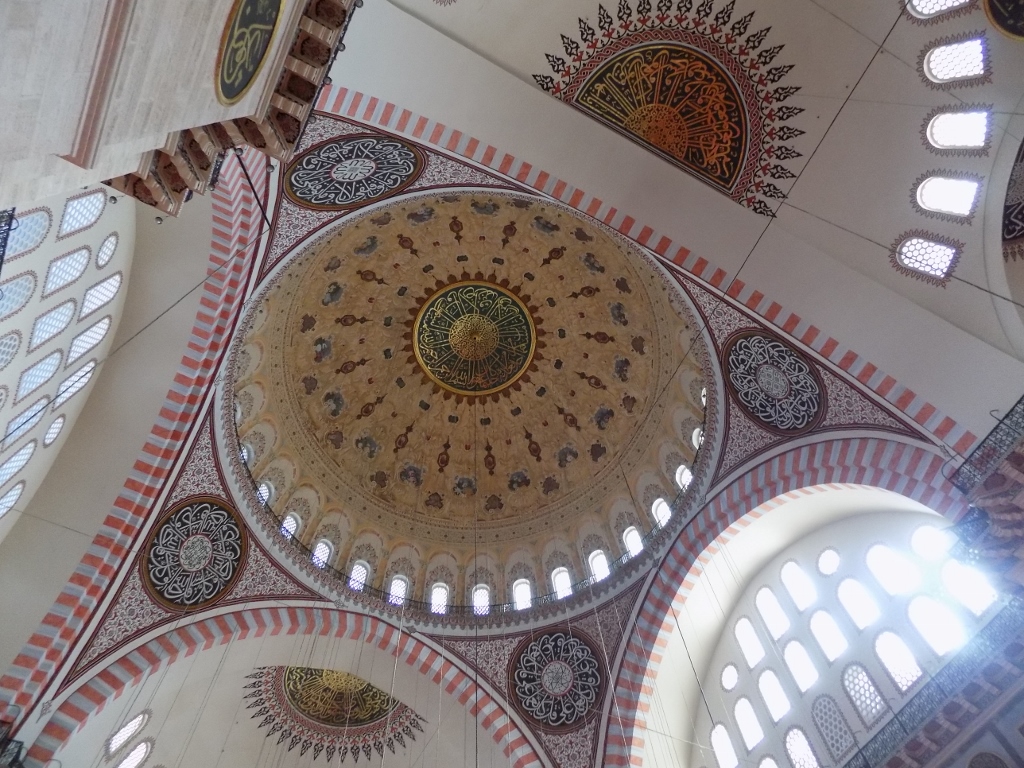 Süleymaniye Mosque
Süleymaniye Mosque
I must emphasise that in every mosque we visited, Sneža and I spent some time. Not too long, but enough to immerse in the architectural and spiritual harmony that permeates these spaces. Spirituality aside, for after all this is a personal thing for each one of us, but settling in one spot certainly leaves the space to take in the impressions at leisure, as well as to pay attention to details that could be easily skipped.
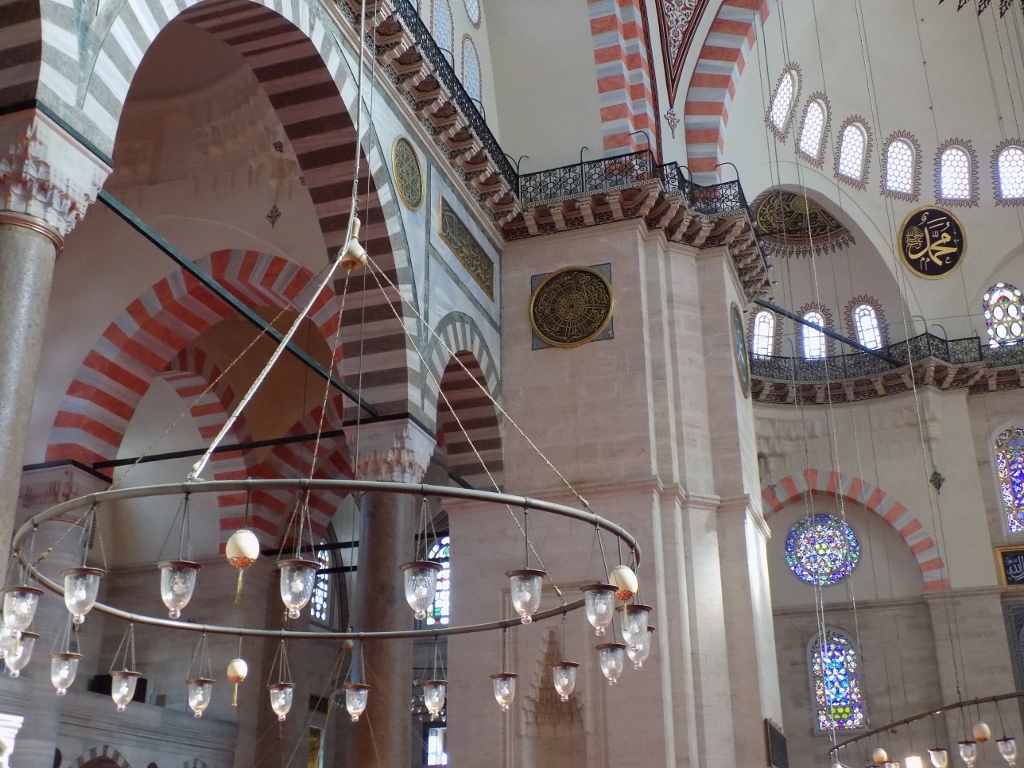 Süleymaniye Mosque: details from the interior
Süleymaniye Mosque: details from the interior
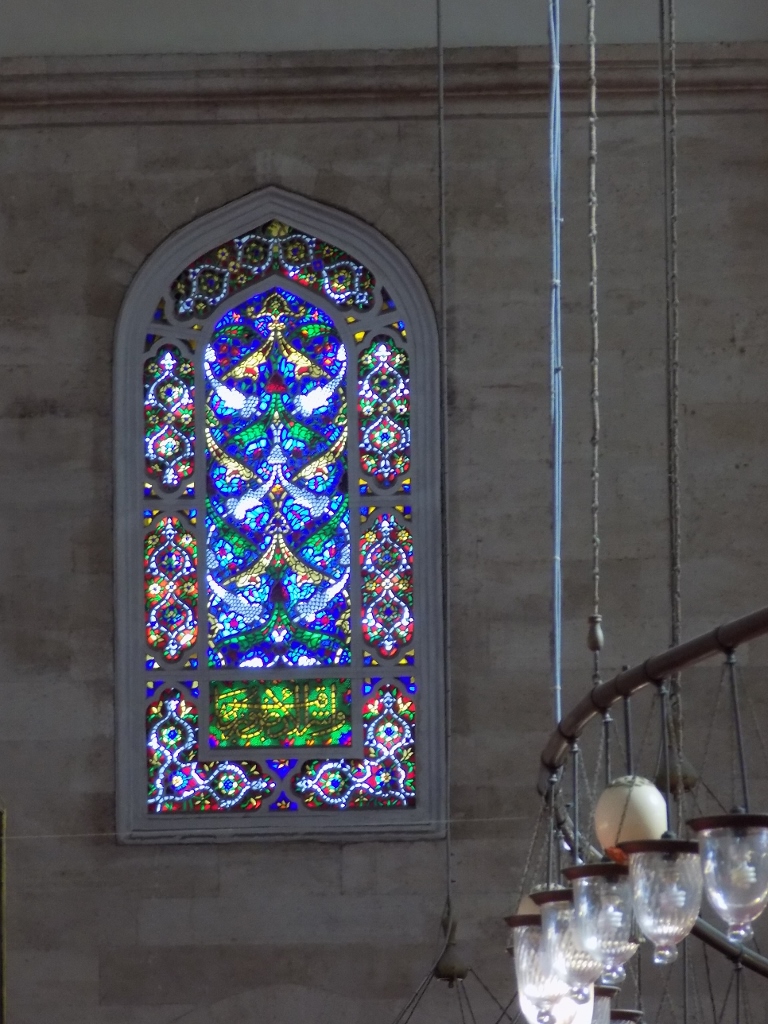 Süleymaniye Mosque: a detail from the interior
Süleymaniye Mosque: a detail from the interior
A little later we also went to the back courtyard where there are tombs of Sultan Suleiman (his daughter Mihrimah was also buried at his mausoleum), as well as a separate sepulchre of his favourite wife – Hurrem Sultan, better known as Roxelana, who was one of the most powerful and most influential women in the Ottoman history and for this reason I mention separately the place where she was laid to rest.
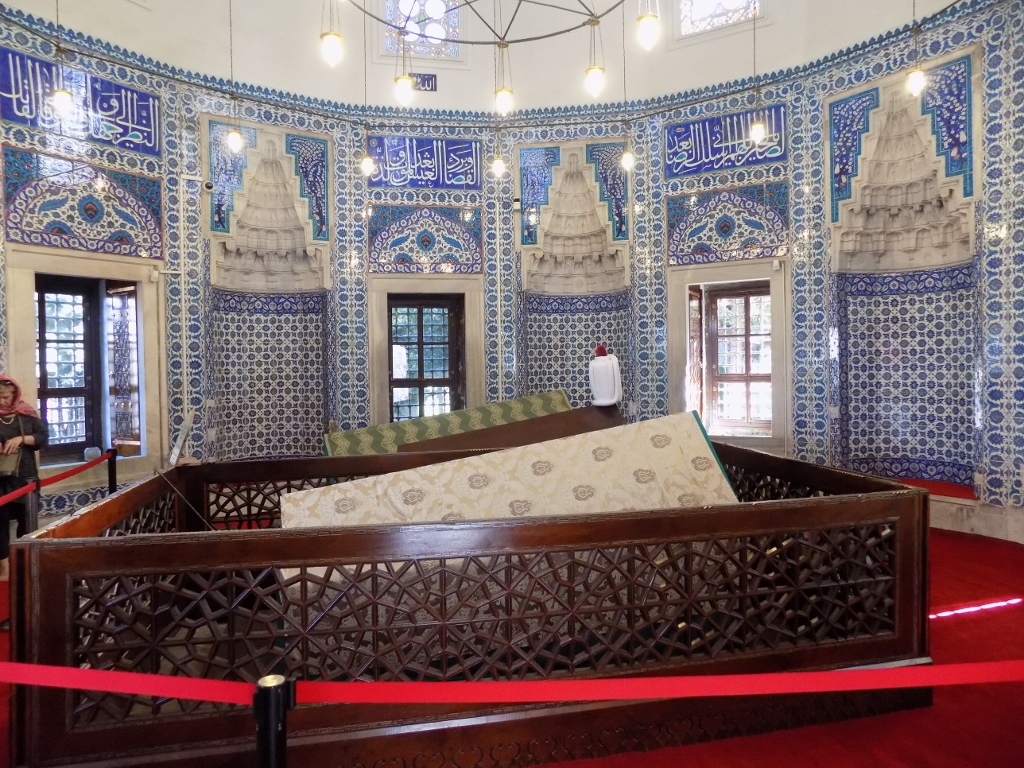 The interior of the mausoleum of Hurrem Sultan
The interior of the mausoleum of Hurrem Sultan
Beside the mosque there is also a large terrace from which there is a splendid view at the Golden Horn, Galata Bridge and Bosphorus, and we stayed there for a while enjoying what this wonderful sunny day and the venue offered.
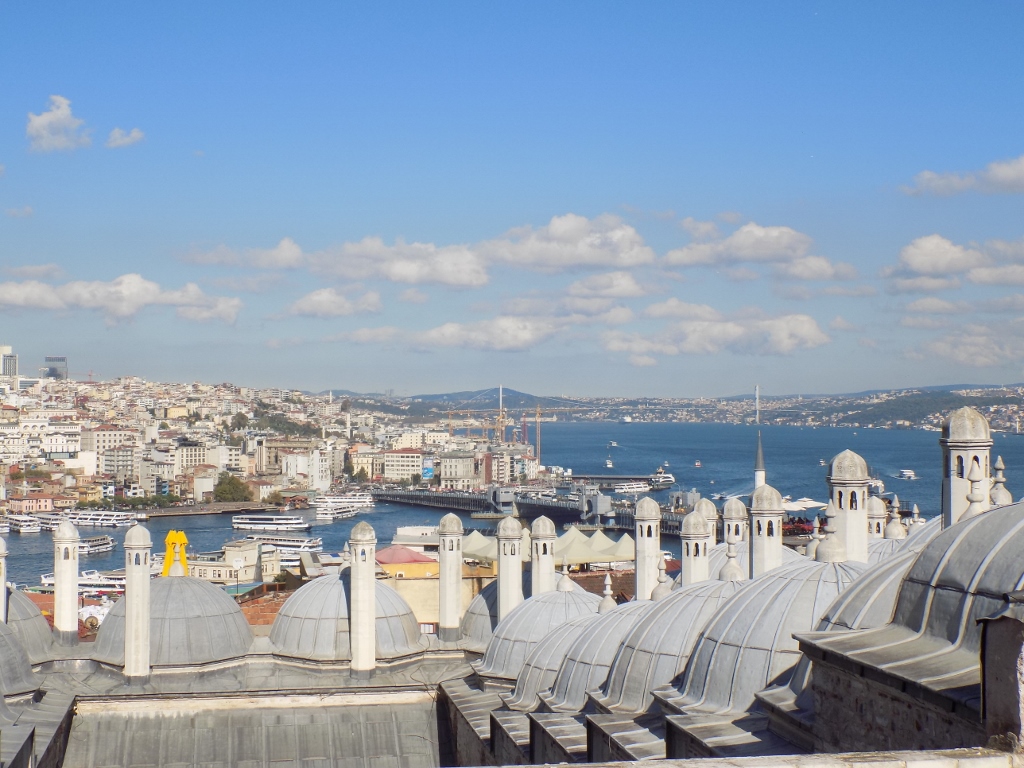 View at the Golden Horn, Galata Bridge and Bosphorus
View at the Golden Horn, Galata Bridge and Bosphorus
And then the time came for the two of us to sit somewhere and have a proper rest, so we opted for one of the numerous cafés-restaurants around the Süleymaniye Mosque that are located at the roofs of the buildings they belong to. The mosque itself was built on the top of one of the hills across which Istanbul spreads and it has an exceptionally prominent position. The cafés and restaurants at a similar place allow one to rest and recuperate well, while also enjoying the stunning view.
Following this break, we descended to the port near the Galata Bridge where we caught public transportation in the shape of a ferry that took us to the Asian side of Istanbul and the part of the city called Kadıköy. Along the way we could witness first-hand the exceptional and prominent position of the Süleymaniye Mosque.
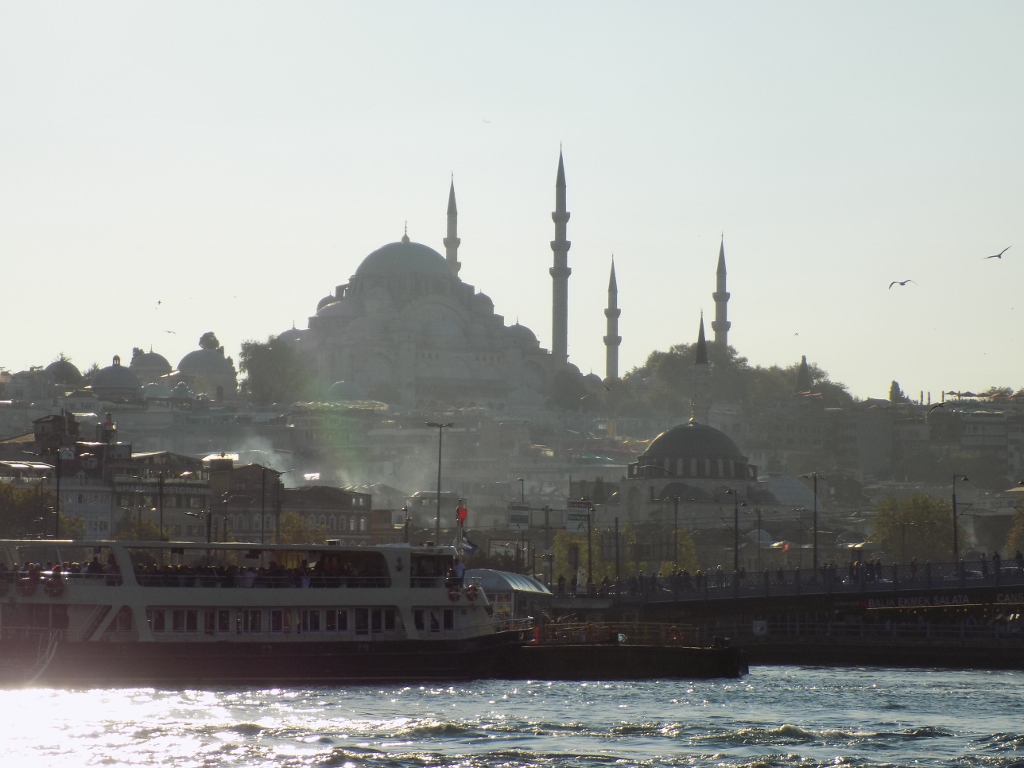 Süleymaniye Mosque on the horizon of Istanbul
Süleymaniye Mosque on the horizon of Istanbul
In Kadıköy we went directly to a part close to the port where there are one restaurant and café next to the other. By this time we felt rather tired and it was important that we sat down again, as well as to eat something.
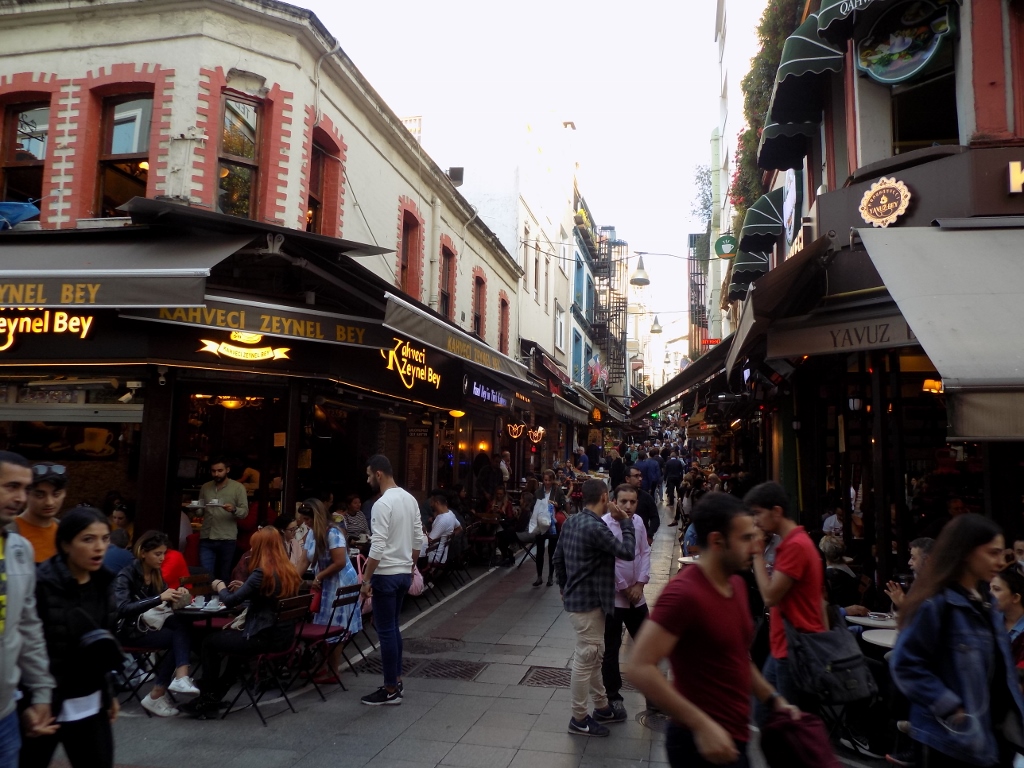 A quarter in Kadıköy with a myriad of restaurants
A quarter in Kadıköy with a myriad of restaurants
Still, here there were not only restaurants and cafés, although it all seemed to be food-related. There were also shops that sold food as if we were in a proper market. We did not mind. Quite the contrary, it only brought in additional interest.
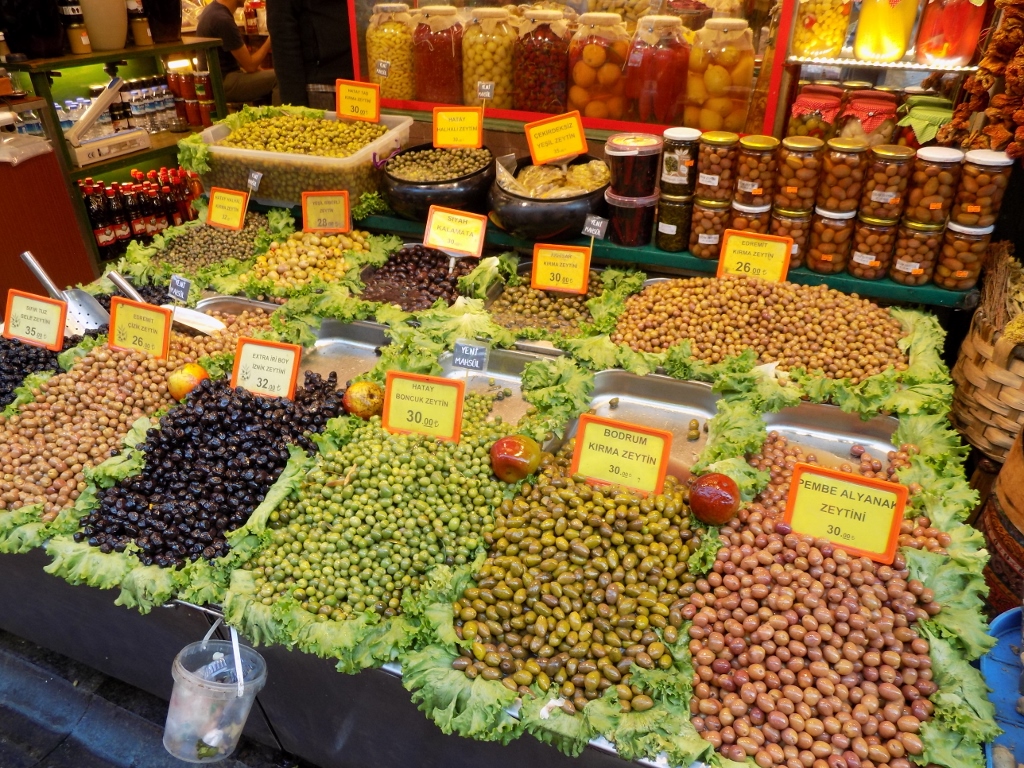 Stand with olives in Kadıköy
Stand with olives in Kadıköy
Eventually we took a seat in a proper restaurant, since Sneža was somewhat hungrier than me. I still felt rather full, so I was not ready to have a normal meal, but a little later we did stop for me to buy a Turkish version of “fast food” and that is lahmacun – Turkish version of a pizza. The dough is even thinner than the one for pizza, so this would actually be something between a pizza and a rolled-up tortilla. In any case, the lahmacun was absolutely great!
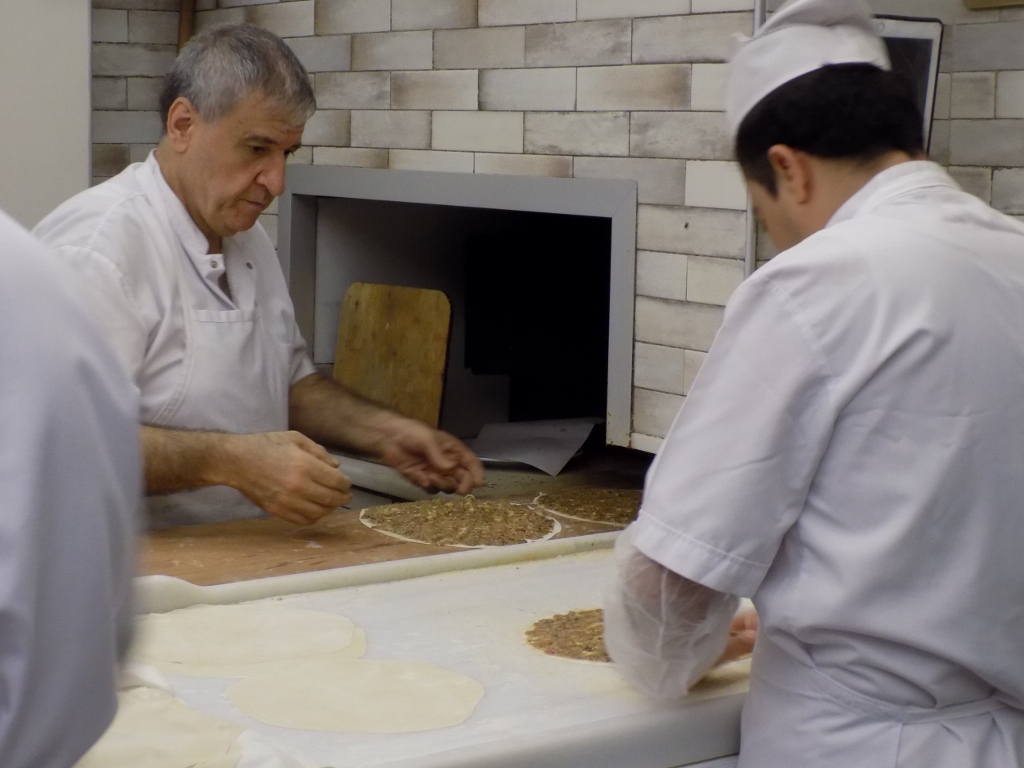 Busy hands are preparing lahmacun
Busy hands are preparing lahmacun
After this we returned to the area surrounding the port, for we were supposed to transfer to Üsküdar, another part of the city that is on the Asian side, since we had good and fast transportation link from there to the Sultanahmet area in which our hotel was. To start with, we caught a dolmuş that we came across right away and that was just about to start in the direction we needed. Dolmuş is the Turkish word for shared taxi, most often in the shape of a mini-bus, and they are an excellent supplement to the standard transportation within and between cities.
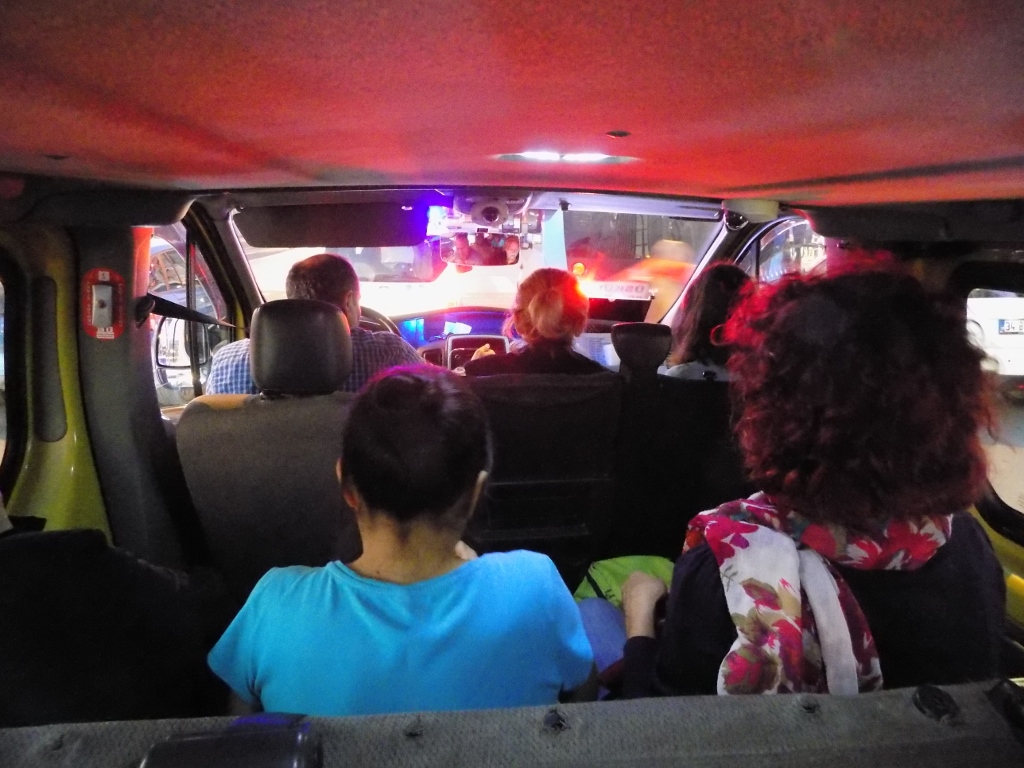 Inside a dolmuş
Inside a dolmuş
When in the centre of Üsküdar we got off right beside another mosque. This was the Yeni Valide Mosque. Although it seemed very pretty, by this time we were far too tired and swamped with impressions to be willing to visit anything else.
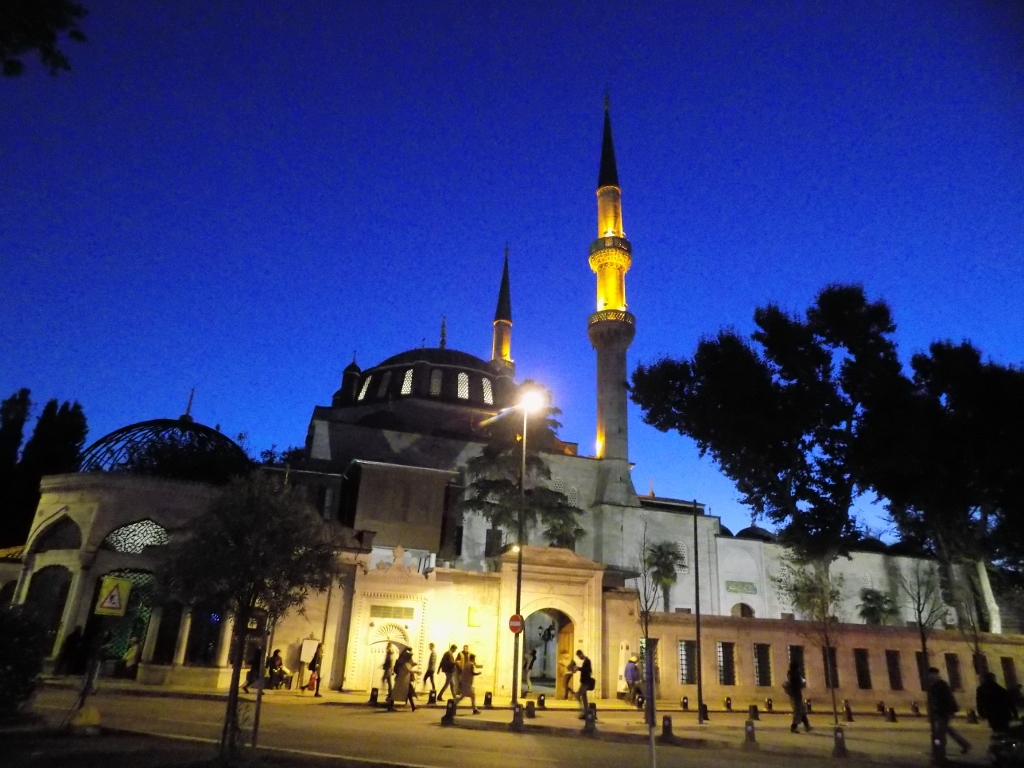 Yeni Valide Mosque in Üsküdar
Yeni Valide Mosque in Üsküdar
Very briefly we walked around and then headed for the city’s railway line station which leads from Üsküdar to Sultanahmet through a tunnel that passed under the Bosphorus straits. There, we tried yet another mode of the public transportation as well.
For the following day, my plan foresaw a completely relaxed time, but in the end we decided that before doing what I had planned we stopped along the way and visited a couple of museums in order to make full use of the museum pass that were valid only that day more. Still, to start with, during my breakfast at the hotel I enjoyed again the view we had from its top.
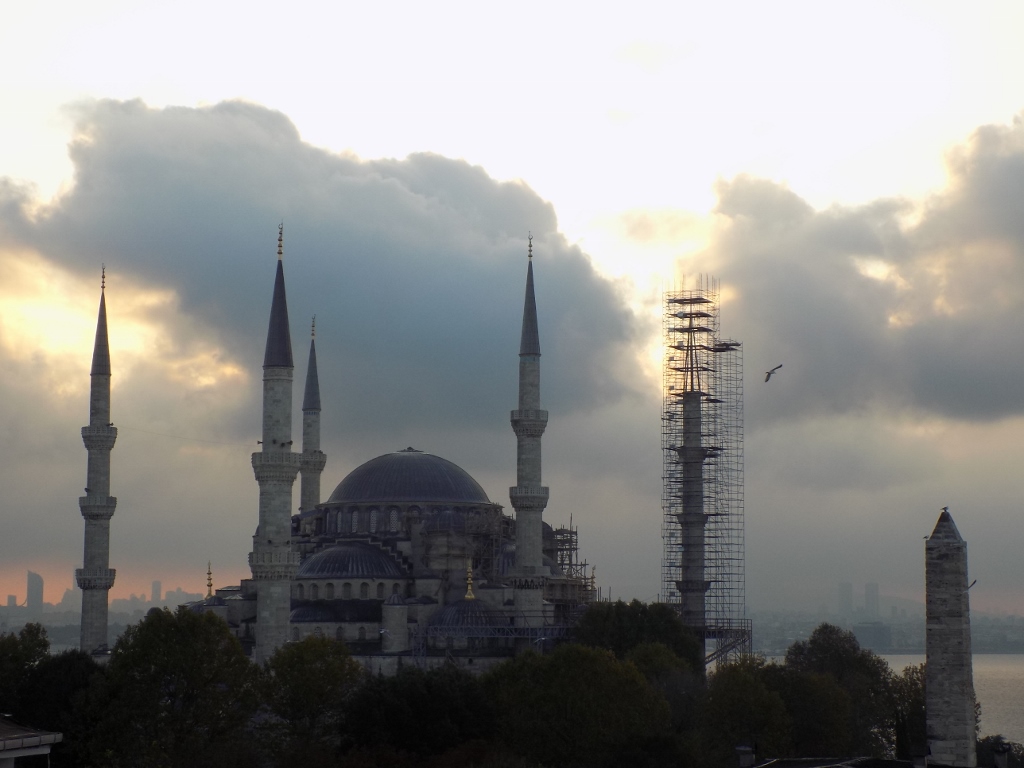 Blue Mosque – view from our hotel
Blue Mosque – view from our hotel
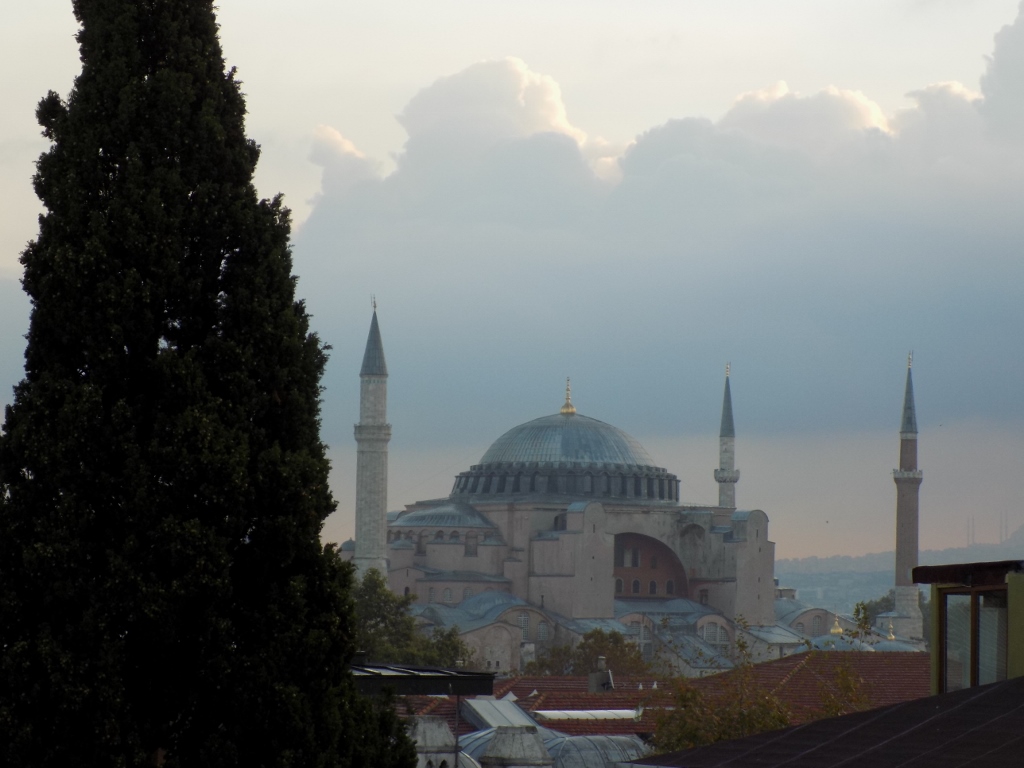 Hagia Sophia – view from our hotel
Hagia Sophia – view from our hotel
In addition to the view, every morning the restaurant also offered great food for breakfast.
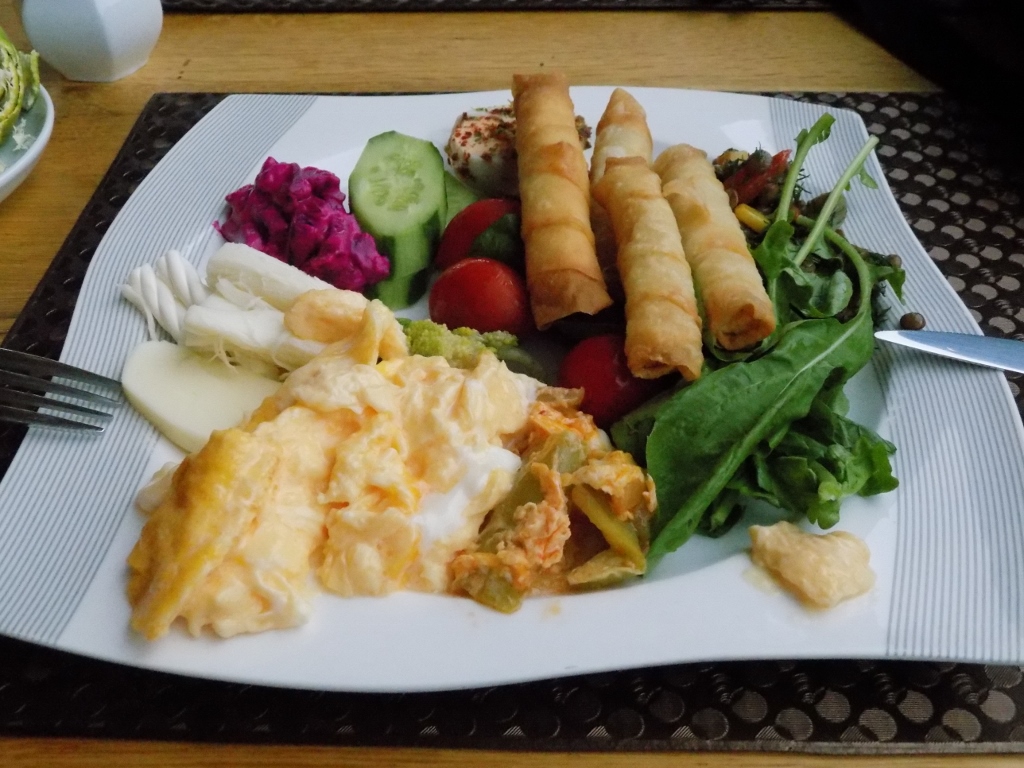 Breakfast of my choice
Breakfast of my choice
When we left the hotel, the first museum on our way was the Museum of Turkish and Islamic Arts, followed by the Istanbul Archaeology Museums. Needless to say, both of these venues have a myriad of great exhibits, since grand civilisations kept replacing one another here, bringing their enormous military power, as well as ensuring the flourishing of culture and arts. Some of the results of that part of the spiritual development may be seen in these two important museums that are very close to the Blue Mosque, Hagia Sophia and the Topkapi Palace. I have decided to include in this text only the photo of a marble sarcophagus made in the Sidamara style which is dated back to the second half of the 3rd century CE.
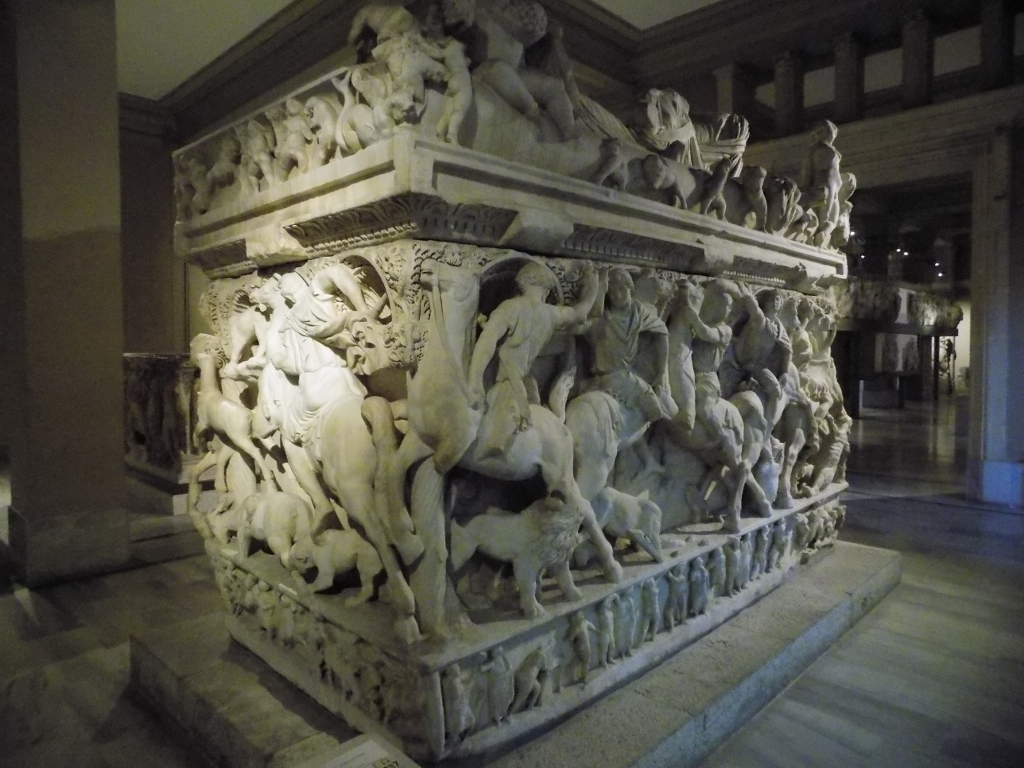 Sidamara style sarcophagus
Sidamara style sarcophagus
Then we took a tram and transferred to its last stop Kabataş for this was where we caught a ferry to the Princes’ Islands. This group of smallish islands is located in the Sea of Marmara, some 20 km south-east of the centre of Istanbul. During summer, there are lots of crowds on the islands, since many people come here in order to escape from the heat of the city. In October it was not that crowded, but the day was nice and we wished to go to these islands and have a look at them. To start with, it was great enjoying sitting on the ship’s deck and watching towards the centre of Istanbul that we were getting away from.
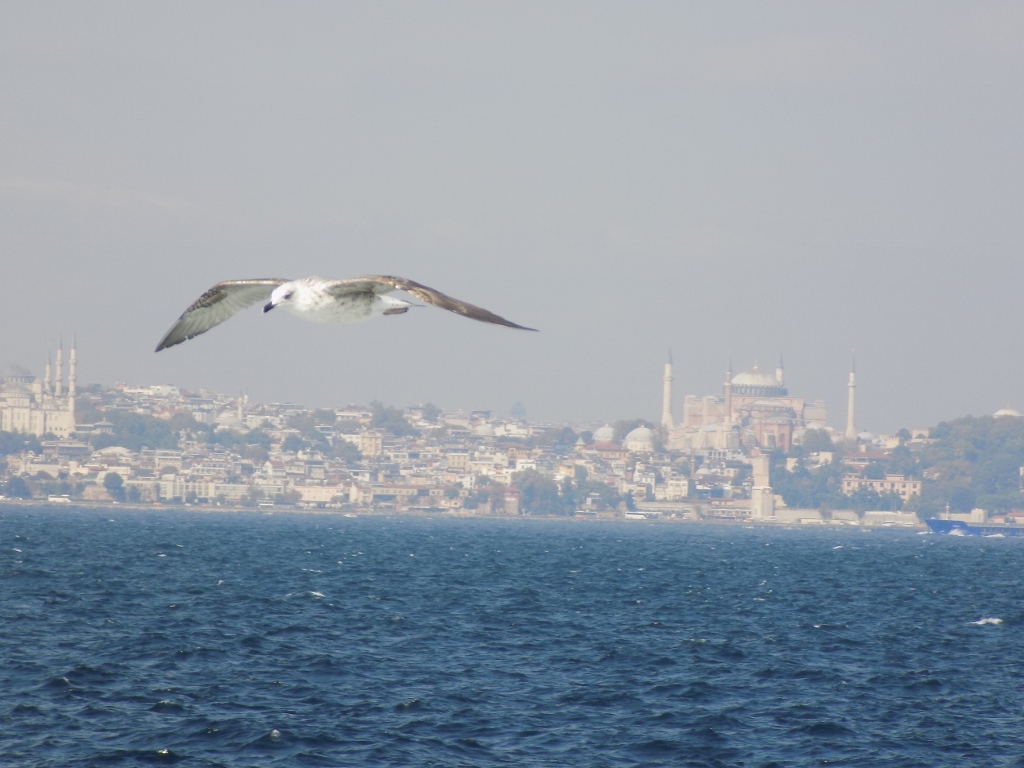 Hagia Sophia remains in the distance
Hagia Sophia remains in the distance
Concretely, we were going to the biggest island in the group – Büyükada, which means – the Big Island. As soon as we disembarked, we immediately went for a walk along the shore in order to find some nice spot by the sea. After a couple of days of intensive walking and sightseeing, even that very morning we visited two museums, we needed to do everything at leisure and slowly. While we were pondering where to sit down and have coffee, there were also some other creatures weighing out whether they can catch that wonderful white bird.
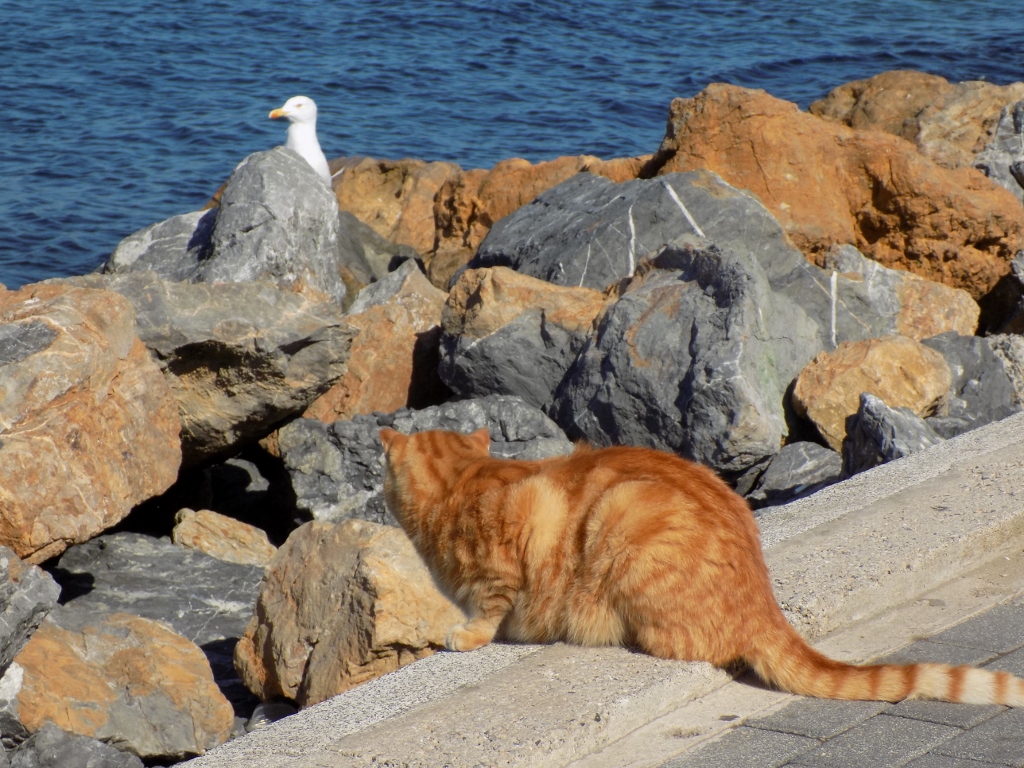 To dash or not to dash, that is the question
To dash or not to dash, that is the question
From this promenade there is a nice view at the newer parts of Istanbul that spread across the Asian side of the city.

After the coffee break, we entered the “side” parts of the small town where there was a somewhat calmer atmosphere and then we reached the centre.
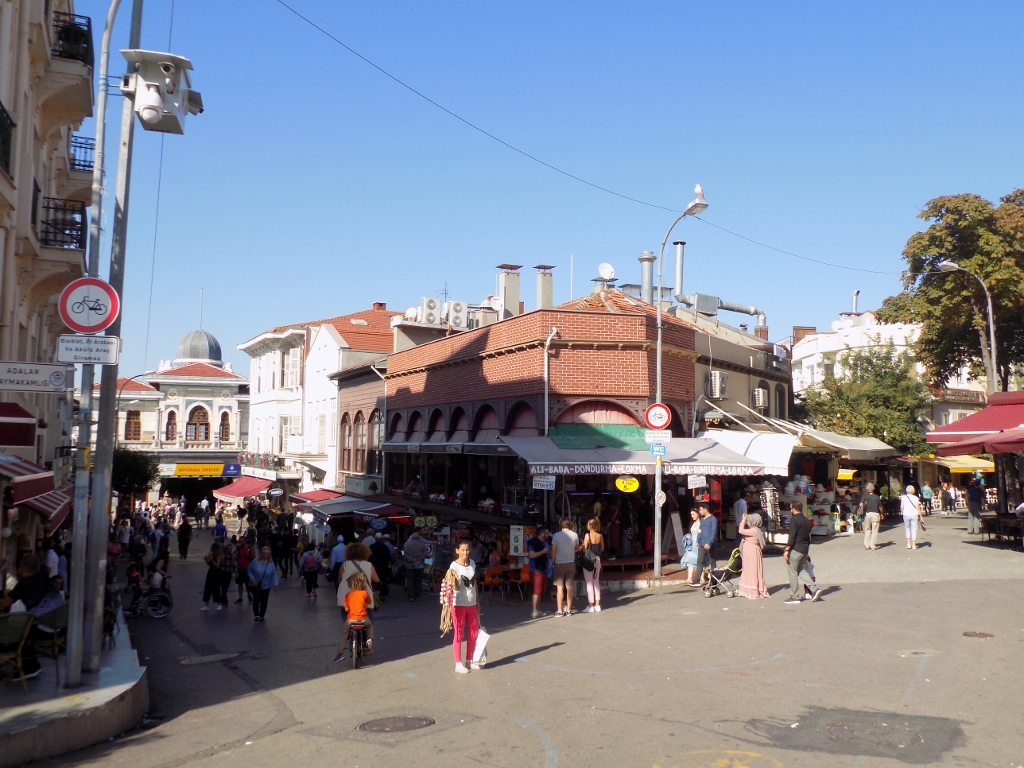 Centre of the town on the island of Büyükada; the port terminal is in the background on the left-hand side
Centre of the town on the island of Büyükada; the port terminal is in the background on the left-hand side
Then we did what all proper tourists do on this island – we rented a horse-drawn phaeton and made a nice circle around the island in it. I was so relaxed that I made almost no photos during that ride. It did not matter. The only thing that mattered was that it was nice and I enjoyed it.
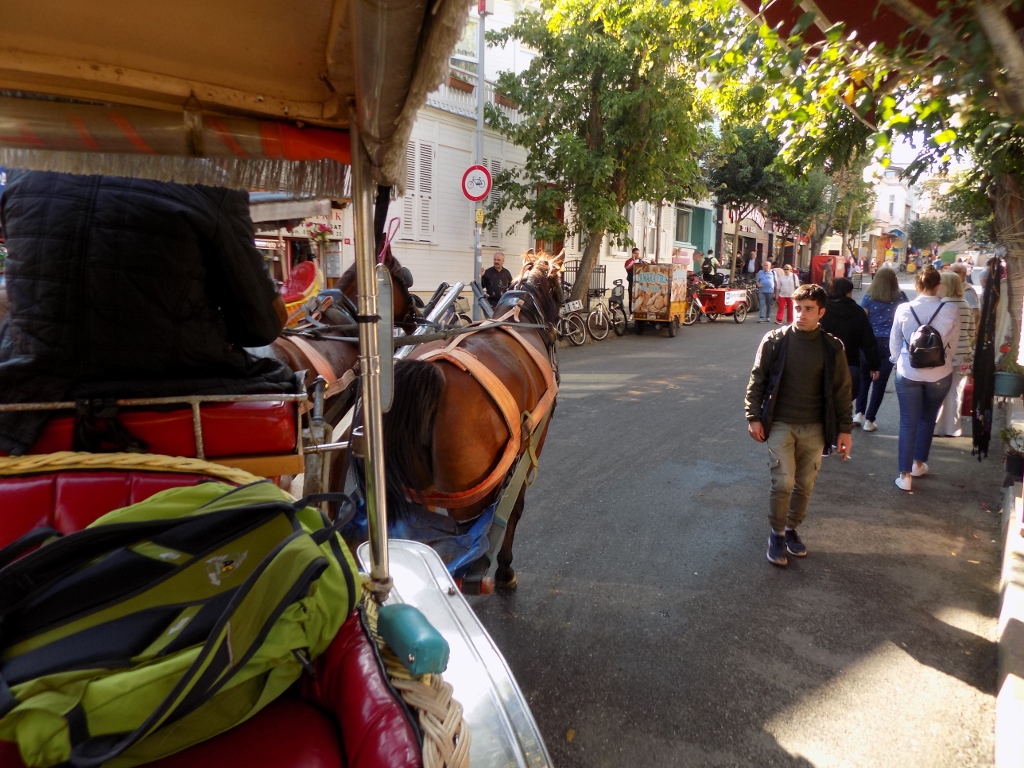 Phaeton in a curve
Phaeton in a curve
And then, when we returned after this small circle around the island, it was already the time for lunch, so we went again to the same promenade on the shore, sat in a restaurant, ordered a wonderful meal and then along with the food we continued to enjoy the pretty view.
